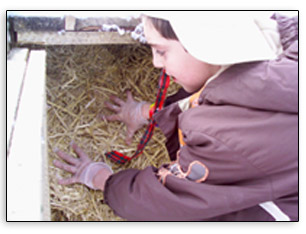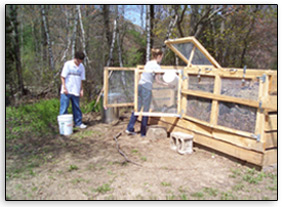How to Compost
- Do a “waste audit” to determine the volume of the organic materials you will be composting.
- Build or buy a rodent-proof bin that will be large enough to house your organic materials. If you are mainly composting food leftovers, which are high in nitrogen, you will need to provide storage space for high-carbon materials such as wood shavings, sawdust, dried leaves, etc.
- Cover food leftovers deposited in bin with 3 times as much carbon material. So, cover a quart of food scraps with three quarts of wood shavings, sawdust, shredded newspaper, etc.
- Keep the pile moist, but not wet.
- Turn the pile to keep it aerated and encourage the aerobic microbes. The more you turn your pile, the faster it will break down.
- Use your compost when there are no visible food scraps, but before it looks like soil and has broken down completely.
- Add red wiggler worms to your pile to assist in decomposition.
How to do a Waste Audit in your School:
Always clear and review your waste audit process with kitchen/cafeteria/custodial staff in advance, and arrange for students to clean up the area after lunch.
- Three student volunteers for each lunch period
- Plastic gloves for volunteers
- One table, about 4-5 feet long
- Two 5-gallon buckets
- One or two trash barrels
- Container for silverware (if you use non-disposable)
- Scale to weigh leftovers
- Chart for recording weight data
Place one trash barrel near where the students normally dump their trash/leftovers and close to the kitchen. Place the table next to the trash barrel so that students will approach the barrel first, and the table is just beyond it. Place a container for non-disposable silverware on the end of the table next to the barrel.
The first student volunteer would stand behind the barrel and take each student's tray, clear it of non-compostable trash, silverware, and large pieces of meat. Then the first volunteer would hand the tray on to the next volunteer (standing behind the table) who would put the leftovers into a bucket. The third volunteer, also standing behind the table will act as a back-up to clear trays if they build up and to manage cleared trays. If you use disposable trays, place another barrel at the far end of the table for cleared trays. If you use non-disposable trays, the third volunteer can also pass the trays into the kitchen for washing.
This works best if students are allowed to come up to the barrel as they finish their lunch, rather than all at once. If this is not possible, it's preferable to dismiss a few tables at a time so that students are not standing in long lines.
At the end of each lunch, volunteers will weigh the leftovers and record the weight and the date. If you don't have compost bins yet, you would then trash the leftovers. (This will inspire you to move on in your plans. Seeing all that food in one place going into the trash makes you realize what a waste of resources this is!). A teacher or other responsible adult should keep the data of leftovers’ weight until the audit is completed.
A side-benefit of the waste audit is that there are lots of fun things math/science (or other) classes can do with this data that will give students a meaningful, personal context for learning.
How to Build a Compost Bin
Click here for photos, plans, and a materials list.
Tips for Composting
The Quabbin Composting and Organic Gardening Program began in March 2008 with the goal of composting all cafeteria leftovers and using the resulting compost to start an organic garden. Produce from the garden is served in the Quabbin cafeteria when school is in session, providing students with delicious, fresh-grown organic produce. In the past two years, we have served fresh greens, carrots, cherry tomatoes, cucumbers and peppers.
Here’s how to do it!
At the end of our lunch periods, student volunteers take the leftovers out to bins and cover them with stored dried leaves, dried grass (NOT green, freshly mowed grass), sawdust, wood shavings, straw or shredded newspaper (NO glossy colored paper; DO NOT add standard white office paper which may contain highly toxic dioxin from the bleaching process).. You can easily do this in your yard. You don’t even need a bin, although a bin is neater and keeps out animals. Ask your local board of health about low-cost bins provided by the State or do a search online for compost bin “images”. You can also visit the Quabbin Regional High School bins at 800 South St., Barre, MA, which are located behind the rear parking lot near the pond or can check out our photos of "HOW TO BUILD A COMPOST BIN".
Once you dump your food or garden scraps, it is important to cover them with the dry “brown” materials listed above. This helps to keep the decomposition aerobic (with air), which avoids the production of methane, a powerful greenhouse gas. When your leftovers go into a land-fill, they create methane because the decomposition is anaerobic or without air. You want to encourage aerobic decomposition in your pile. This also avoids the odors and slimy mess of anaerobic decomposition often associated with garbage.
If you add 3 times the volume of brown materials every time you dump your food or kitchen scraps, you will not have an odor problem or a fly problem. So, if you dump a quart of kitchen scraps, you will want to cover with 3 quarts of brown materials. If you dump a half gallon of scraps, you will want to cover with a gallon and a half. The ratio is 3 “brown or dry” to 1 “wet or green”. Other “wet or green” materials include freshly-mowed grass or fresh garden plants or trimmings.
People often ask which foods they can put in their compost, and much misinformation abounds. Any organic material can be composted, including cheese, milk and meat. Meat should be chopped or put through a blender so that it can mix with the “brown” materials going into your pile. The problem with meat is that it is a very dense source of nitrogen and can’t combine with the carbon unless it is in small pieces.
It helps to turn or stir up your compost materials from time to time. It is not necessary to do this every day or even weekly if you maintain the 3-1 ratio, but it helps add air and shortens the decomposition process. The more air added to the pile, the livelier the microbes and the faster things break down.
It also helps to have two bins or piles so that you can leave the first and let it decompose while adding to the second. However, it is possible to have only one and to remove the finished compost that accumulates at the bottom of the pile as you go along.
Moisture – not wringing wetness – is important to your pile. If rain cannot reach your materials, you will need to water it lightly occasionally.
Adding earthworms to you pile can also be helpful. When the aerobic microorganisms that do most of the work are done, the larger decomposers, like earthworms, take over and finish off the job.
Compost is done when it is dark and crumbly and looks like rich soil. You can apply compost to your vegetable or flower garden or landscaping. Compost is one of the best ways to maintain health and fertility in your garden. It is alive with microorganisms that help feed your plants and reduce disease problems in your soil and plants – a great way to prevent problems in the garden before they start. Compost-fertilized plants also tend to have fewer insect pests because they are healthy, just as properly-nourished people get fewer diseases or recover from them more quickly.



